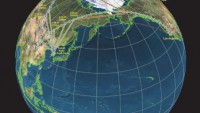North Korea Might Deploy Intermediate Range Musudan Nuclear Missiles by 2017
| Arthur Dominic Villasanta | | Oct 19, 2016 09:01 AM EDT |
(Photo : Korean People's Army) Hwasong-10 launch.
There are indications North Korea might be further ahead than expected in finishing the development of its Hwasong-10 (Musudan) mobile intermediate-range ballistic missile (IRBM) that might be able to reach the vicinity of Guam. This missile can carry a nuclear warhead.
North Korea has conducted seven tests involving eight Musudans from this April until Oct. 15. None of these tests were considered completely successful by the west. One test, a launch of two Musudans last June 22 from Wonsan, was considered a partial success.
Like Us on Facebook
North Korea, however, praised the twin launches as a complete success. The latest test on Oct. 15 from Kusong on the west coast was a complete failure that saw a Musudan destroyed at launch.
The U.N. Security Council strongly condemned for the October launch, calling it a "grave violation" of resolutions banning North Korea from using ballistic missile technology.
First revealed in 2010, Hwasong-10 is a liquid fueled IRBM capable of carrying a 1,000 kg high explosive warhead and, later on, a nuclear warhead if the North ever perfects this technology. North Korea claims the missile can reach out to 4,000 km but western analysts believe this to be false based on the trajectories of the missiles used in its tests.
Despite the mostly failed record of the Hwasong-10, the American think tank 38 North believes North Korea is on track to perfect Hwasong-10 faster than expected.
It cited an aggressive schedule with multiple tests and believes the latest launch from Kusong suggests Hwasong-10 might enter service as early as 2017. The website is part of Johns Hopkins University's School of Advanced International Studies.
It believes the North Koreans aren't "taking the slow path to developing a reliable system, with a year or so between each test to analyze the data and make improvements ... instead, they are continuing with an aggressive test schedule that involves, at least this time, demonstrating new operational capabilities."
The frequent launches of the missile increase the probability of failures, but "it means they will learn more with each test."
The think tank noted that launching from the west coast allows the missile to achieve longer range without flying over neighboring countries such as Japan.
Previous tests from the east coast were limited to 400 kilometers or so to avoid Japanese airspace. To compensate, the North decided on a lofted trajectory that "probably did not demonstrate the missile's full performance."
"From the west coast, launching south, a North Korean missile could fly 3,000 kilometers (1,900 miles) or more before splashing down in the Philippine Sea," said the report by 38 North (a reference to the 38th Parallel dividing North and South Korea).
TagsHwasong-10 (Musudan), intermediate-range ballistic missile, IRBM, North Korea, 38 North, Guam
©2015 Chinatopix All rights reserved. Do not reproduce without permission
EDITOR'S PICKS
-

Did the Trump administration just announce plans for a trade war with ‘hostile’ China and Russia?
-

US Senate passes Taiwan travel bill slammed by China
-

As Yan Sihong’s family grieves, here are other Chinese students who went missing abroad. Some have never been found
-

Beijing blasts Western critics who ‘smear China’ with the term sharp power
-

China Envoy Seeks to Defuse Tensions With U.S. as a Trade War Brews
-

Singapore's Deputy PM Provides Bitcoin Vote of Confidence Amid China's Blanket Bans
-

China warns investors over risks in overseas virtual currency trading
-

Chinese government most trustworthy: survey
-

Kashima Antlers On Course For Back-To-Back Titles
MOST POPULAR
LATEST NEWS
Zhou Yongkang: China's Former Security Chief Sentenced to Life in Prison

China's former Chief of the Ministry of Public Security, Zhou Yongkang, has been given a life sentence after he was found guilty of abusing his office, bribery and deliberately ... Full Article
TRENDING STORY

China Pork Prices Expected to Stabilize As The Supplies Recover

Elephone P9000 Smartphone is now on Sale on Amazon India

There's a Big Chance Cliffhangers Won't Still Be Resolved When Grey's Anatomy Season 13 Returns

Supreme Court Ruled on Samsung vs Apple Dispute for Patent Infringement

Microsoft Surface Pro 5 Rumors and Release Date: What is the Latest?














